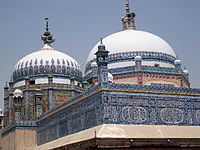
Saraiki culture is the culture of the Saraiki people, residing in Pakistan and outside Pakistan.
Clothing
The traditional dress of Saraiki People is the Shalwar kameez; This is also the national dress of Pakistan. Traditional Sajarak is an important part of Saraiki male and female dress.
Cuisine
Mango is a seasonal fruit of the region during summers.[1] Sohan halwa is a traditional speciality of southern Punjab, particularly Multan.[1] The southern Punjab cities of Dera Ghazi Khan, Bahawalpur, Uch Sharif and Mailsi are also known for their sohan halwa products.[1] Multani Chaamp is a meat dish consisting of lamb chops prepared with various flavours and spices, placed on sewers and grilled over charcoal.[2]
Religion
The region of Saraikistan is renowned for its Sufi heritage. The city of Multan is known as the city of saints.[3] It has the shrines of Baha-ud-din Zakariya, Shah Rukn-e-Alam and Shah Yousef Gardez. Similarly, Uch Sharif has been the centre of Qadiriyya Sufi order.
Art and music
Jhumar
Jhumar or Jhoomar (also called Ghumbar in Sandalbar area)[4] is a traditional Saraiki and Baloch dance in Pakistan.[5][6] It is also popular in the Sandalbar areas of Punjab.[7] It is slower and more rhythmic form.[8] The word "Jhumar" comes from Jhum/Jhoom, which means Swaying. Jhumar is performed at the wedding ceremonies usually.[9] The dance is also performed in circle, to the tune of emotional songs.[9] Ataullah Khan Esakhelvi and Shafaullah Rokhri are considered the main singers of Saraiki music.[10]
Literature

The language, partly codified during the British Raj, derived its emotional attraction from the poetry of the Sufi saint, Khawaja Ghulam Farid, who has become an identity symbol.[11] His poems, known as Kafi are still famous.
Shakir Shujabadi (Kalam-e-Shakir, Khuda Janey, Shakir Diyan Ghazlan, Peelay Patr, Munafqan Tu Khuda Bachaway, and Shakir De Dohray are his famous books) is a very well recognized modern poet.[12]

The Department of Saraiki, Islamia University, Bahawalpur was established in 1989[13] and the Department of Saraiki, Bahauddin Zakariya University, Multan[14] was established in 2006. Saraiki is taught as a subject in schools and colleges at higher secondary and intermediate.[15][16] Saraiki is also taught at degree level at the Allama Iqbal Open University at Islamabad,[17] and the Al-Khair University at Bhimbir have Pakistani Linguistics Departments. They offer M.Phil. and Ph.D in Saraiki. The Associated Press of Pakistan has launched a Saraiki version of its site, as well.[18]
| Saraiki alphabet |
|---|
| آ ا ب ٻ پ ت ٹ ث ج ڄ چ ح خ د ڈ ݙ ذ ر ڑ ز ژ س ش ص ض ط ظ ع غ ف ق ک گ ڳ ل م ن (ں) ݨ و ہ ھ ی ے |
|
Extended Perso-Arabic script |
Saraiki is written using the Arabic-derived Urdu alphabet with the addition of seven diacritically modified letters to represent the implosives and the extra nasals.[19][a] In Sindh the Sindhi alphabet is used.[20] The calligraphic styles used are Naskh and Nastaʿlīq.[21]
Historically, traders or bookkeepers wrote in a script known as kiṛakkī or laṇḍā, although use of this script has been significantly reduced in recent times.[22][23] Likewise, a script related to the Landa scripts family, known as Multani, was previously used to write Saraiki. A preliminary proposal to encode the Multani script in ISO/IEC 10646 was submitted in 2011.[24]
See also
- South-Punjab
- Saraiki people
- List of Saraiki people
- Saraiki cuisine
- Saraiki diaspora
- List of Seraiki tribes
- Saraiki literature
References
Notes
- ^ The practice is traced back to Juke's 1900 dictionary. The modern standard was agreed upon in 1979 (Wagha 1997, pp. 240–41).
Citations
- ^ a b c "Sohan Halwa a gift of saints' city". Dawn.com. 16 December 2013. Retrieved 3 May 2014.
- ^ "Multani Chaamp". NDTV Food. Retrieved 5 September 2015.
- ^ Dawn.com (2012-03-19). "Multan: The city of saints". DAWN.COM. Retrieved 2023-01-08.
- ^ Dhillan, I. S. (1998). Folk Dances of Panjab. National Book Shop. p. 55. ISBN 978-81-7116-220-8.
- ^ "International Dance Day is being observed today". Global Village Space. 2019-04-29. Retrieved 2023-01-16.
- ^ "Of culture and political identity | Art & Culture | thenews.com.pk". www.thenews.com.pk. Retrieved 2023-01-16.
- ^ Punjab District Gazetteers: Shahpur District. 1897. p. 93.
- ^ "Jhumar Dance - Folk Dance Performed on Marriage Ceremonies by Men". Archived from the original on 2015-08-29. Retrieved 2015-01-16.
- ^ a b Manga, Dhiren (2018-08-21). "The Most Popular Dances of Pakistan". DESIblitz. Retrieved 2023-01-16.
- ^ "Legendary Saraiki singer Shafa Ullah passes away". The Express Tribune. 2020-08-29. Retrieved 2020-09-05.
- ^ Jaffrelot, Christophe (2016-06-16). The Pakistan Paradox: Instability And Resilience. Random House India. p. 187. ISBN 978-81-8400-707-7.
- ^ "Shakir Shujabadi".
- ^ "The Islamia University of Bahawalpur Pakistan - Department". iub.edu.pk.
- ^ "Bahauddin Zakariya University, Multan, Pakistan". bzu.edu.pk.
- ^ "Govt plans to recruit teachers of Punjabi, Seraiki languages". DAWN.COM. 12 February 2022.
- ^ "In a first, K-P introduces regional-language books in govt schools". The Express Tribune. 27 February 2017.
- ^ "Department Detail". aiou.edu.pk.
- ^ "Associated Press Of Pakistan ( Pakistan's Premier NEWS Agency ) - Saraiki". app.com.pk.
- ^ Shackle 2003, pp. 598–99.
- ^ Shackle 2014.
- ^ Lewis, Simons & Fennig 2016.
- ^ Shackle 2003, p. 594.
- ^ Wagha 1997, pp. 239–40.
- ^ "Preliminary Proposal to Encode the Multani Script in ISO/IEC 10646" (PDF).
Sources
- Lewis, M. Paul; Simons, Gary F.; Fennig, Charles D., eds. (2016). "Saraiki". Ethnologue (19 ed.). Archived from the original on 25 April 2019.
- Shackle, Christopher (2003). "Panjabi". In Cardona, George; Jain, Dhanesh (eds.). The Indo-Aryan languages. Routledge language family series. Y. London: Routledge. pp. 581–621. ISBN 978-0-7007-1130-7.
- —— (2014). "Siraiki language". Encyclopædia Britannica. Retrieved 2016-10-18.
- Wagha, Muhammad Ahsan (1997). The development of Siraiki language in Pakistan (Ph.D.). School of Oriental and African Studies.








